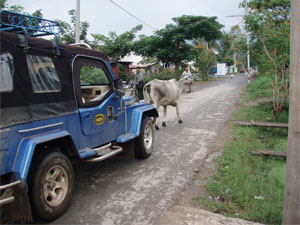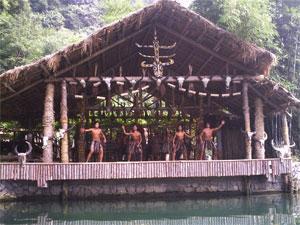Crossing the Globe: When
Vernacular and Transnational Mix
By Lindsay Kuhlmann
Semester
at Sea is
a voyage around the world. While traditional classes are taken by
students, it
is the non-traditional learning methods that have taught me the most
during
this voyage. In class, Professor Koptiuch taught us to see the
differences
between vernacular (traditional) and transnational (global) worlds.
Visually we
were able to see videos of global cities around the world. The class
saw the
difference in architecture, people, and scenery in these videos and
read
articles of current issues affecting the cities. When the ship would
dock in
the cities that we had studied there was a sense of preparation. Soon,
however,
we would find that the learning had just begun.
 All
the videos in class could not prepare us for the personality of the
cities that
smacked us in the face in each port. While exploring the cities,
students saw familiar
buildings
and sites. This was thanks to the educational
videos we watched
in class. Yet entering the cities that we studied was like taking a
trip to
space after studying the planets. Nothing can compare. We were able to
see
modern day Cairo where
ancient
pyramids shared the skyline with modern sky-rise apartments. Vietnam
was once a place we learned about when studying the Vietnam War but now
it had
become a place where we saw the vernacular mixing with the
transnational. We
started to see examples of the issues affecting global cities, like
gated
communities, run-down apartment buildings due to lack of housing, and
the
accumulation of slums. The sights we saw burned images into our minds.
How can we
forget Yangon, Burma,
where McDonald’s and Burger King had not yet arrived, which was one of
the only
places we visited where this was true. All
the videos in class could not prepare us for the personality of the
cities that
smacked us in the face in each port. While exploring the cities,
students saw familiar
buildings
and sites. This was thanks to the educational
videos we watched
in class. Yet entering the cities that we studied was like taking a
trip to
space after studying the planets. Nothing can compare. We were able to
see
modern day Cairo where
ancient
pyramids shared the skyline with modern sky-rise apartments. Vietnam
was once a place we learned about when studying the Vietnam War but now
it had
become a place where we saw the vernacular mixing with the
transnational. We
started to see examples of the issues affecting global cities, like
gated
communities, run-down apartment buildings due to lack of housing, and
the
accumulation of slums. The sights we saw burned images into our minds.
How can we
forget Yangon, Burma,
where McDonald’s and Burger King had not yet arrived, which was one of
the only
places we visited where this was true. 
One
of the most important differences we saw traveling around the world was
the
transition from Asia to Europe.
Buddhist
temples slowly began to be replaced by church steeples and the prayer
calls of
mosques. Shaved heads became covered heads. Personally, the two
countries that
I found the most fascinating were China
and Spain.
Both
were modern in their own way and both had their own vernacular
particularities.
It was amazing to see the global similarities mixed in with the
vernacular
differences.
The
object of this project will be to show the reader these two countries
through
my eyes and point out the vernacular and transnational differences
between Spain
and China.
By
the end the reader should be questioning whether there truly is a
vernacular
when a
country is considered transnational.
First read my discussions of the
two countries by clicking on the links here, and then read my analysis
below:
China Article: Same Country, Two Different Worlds
Spain Article: Vernacular in a
Transnational World
Analysis
When
questioning whether a country
can still maintain some of its truly vernacular elements when it has
come to be
considered transnational I do not mean to say that Spain
and China
have
become exactly the same country. They do maintain their differences
based on
their vernacular pasts but rather these vernacular pasts have shifted
meanings
due to their transnational status. In order to illustrate my point
further I’d
like to use the example of another Asian country, Burma.
 Burma,
to me, is closer to a vernacular country than any of the other Asian
countries we visited. Due to the fact that Burma
has in power a military regime that has
“aggressively transformed the
capital
city in line with strategic, commercial and ideological goals"
(Seekins,
pg
258) the cities' only new buildings are giant hotels owned by the
government.
These new hotels symbolized a transnational world
in a
vernacular state. They have every amenity a rich foreign traveler
could ask
for but nothing a Burmese citizen would. The Burmese seemed unaffected
by the
commercialism that comes with a transnational world and rather seemed
very
content with their daily lives. Visiting
Inlay Lake,
my friends and I arrived during one of the yearly boat festivals.
Unlike Spain
where the Flamenco dancers perform night after night for tourists, the
people observing the boat races included only about ten tourists and
the rest were
Burmese.
The organizers of the boat races didn’t care if we knew what was going
on, they
were there for the villagers competing in the races. This was much
different
than other experiences I had in more transnationalized countries that
have made
their
traditions something for tourists to see rather than for their own
people.
Burma,
to me, is closer to a vernacular country than any of the other Asian
countries we visited. Due to the fact that Burma
has in power a military regime that has
“aggressively transformed the
capital
city in line with strategic, commercial and ideological goals"
(Seekins,
pg
258) the cities' only new buildings are giant hotels owned by the
government.
These new hotels symbolized a transnational world
in a
vernacular state. They have every amenity a rich foreign traveler
could ask
for but nothing a Burmese citizen would. The Burmese seemed unaffected
by the
commercialism that comes with a transnational world and rather seemed
very
content with their daily lives. Visiting
Inlay Lake,
my friends and I arrived during one of the yearly boat festivals.
Unlike Spain
where the Flamenco dancers perform night after night for tourists, the
people observing the boat races included only about ten tourists and
the rest were
Burmese.
The organizers of the boat races didn’t care if we knew what was going
on, they
were there for the villagers competing in the races. This was much
different
than other experiences I had in more transnationalized countries that
have made
their
traditions something for tourists to see rather than for their own
people.
 Even in China,
the traditional village that I visited seemed aimed at tourists. While
I am
sure there that these villages did function solely for the people
living in
them at one point, due to the transnational influence on the vernacular
these
village traditions have transformed over time. Dances and songs that
were once
only sung
on special occasions are now sung multiple times every day for
tourists.
Every vernacular aspect in the village had somehow been touched and
changed by
the transnational. Even in China,
the traditional village that I visited seemed aimed at tourists. While
I am
sure there that these villages did function solely for the people
living in
them at one point, due to the transnational influence on the vernacular
these
village traditions have transformed over time. Dances and songs that
were once
only sung
on special occasions are now sung multiple times every day for
tourists.
Every vernacular aspect in the village had somehow been touched and
changed by
the transnational.
Conclusion
Next time that you
are traveling and witnessing the “vernacular” ask yourself if what you
are
watching or participating in is being aimed at the citizens of a
country or at
the other tourists. The vernacular traditions are
what
separates one country from another, whereas the transnational is the
common
thread that makes this world all that much smaller. Spain
and China both
have their differences based on their vernacular pasts but the more
their
cultures become transnationalized the more their similarities grow.
|

 All
the videos in class could not prepare us for the personality of the
cities that
smacked us in the face in each port. While exploring the cities,
students saw familiar
buildings
and sites. This was thanks to the educational
videos we watched
in class. Yet entering the cities that we studied was like taking a
trip to
space after studying the planets. Nothing can compare. We were able to
see
modern day
All
the videos in class could not prepare us for the personality of the
cities that
smacked us in the face in each port. While exploring the cities,
students saw familiar
buildings
and sites. This was thanks to the educational
videos we watched
in class. Yet entering the cities that we studied was like taking a
trip to
space after studying the planets. Nothing can compare. We were able to
see
modern day 

 Even in
Even in